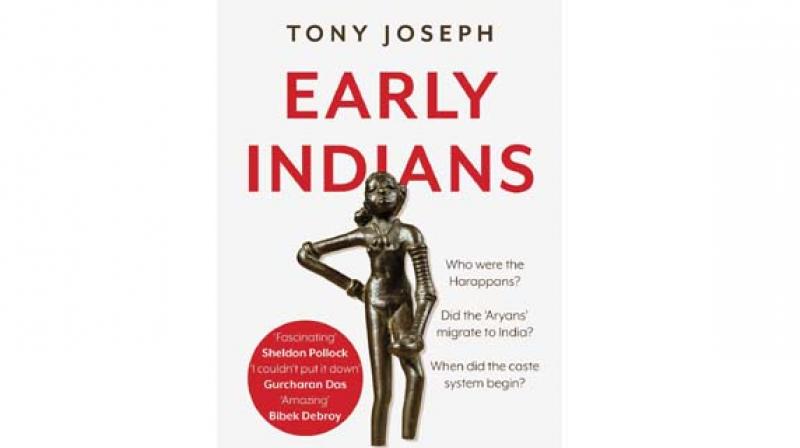The x, y and gene of pre-historic India
The Indian population itself \"is mostly the result of four major prehistoric migrations.

"Cupid ought to put down his bow and arrow and become a stone pelter." A Valentine's Day-themed attempt at social media humour drew a fascinating observation: Cupid and the Indian God of Love, Kama, both use a bow and arrow. Two strikingly different cultures, with a vast array of motifs, happen upon the same one as the grand facilitator of love. The cow, the symbol of fertility and abundance according to Indian cultures, has become the butt of many a joke in today's acrimonious political climes. And still, the King of Crete, in Greek mythology, is presented with a white buffalo, the keeper of prosperity. In Norse mythology, the hornless cow, with the milk that flowed like rivers, revealing Buri, the ancestor of the gods.
Symbology and myths have been a matter of intrigue, studied by scholars and philosophers across the world, from Descartes and Jung to Thomas Mann and Joseph Campbell. As troublesome as this thought might be during an age defined by the 'search for identity', are we all more similar than we think? More importantly, who are we? How did we get here? Who actually wrote the Vedas? Journalist and author of Early Indians, Tony Joseph tells Darshana Ramdev, how some six years ago, he set out to find the answers to those questions exactly.
As we continue to squabble over whether or not the Aryans invaded, if ancient Indo-Chinese cultures are older than the Mesopotamian civilisations – the answer, as paleoanthropology now substantiates, is a sobering one. Perhaps we all came from the same place. Perhaps that place is Africa...
Early Indians, the mammoth effort by Tony Joseph is a wonderful journey on which to embark, but the more impassioned reader must beat a retreat from the gulags of political debate to the ever-shrinking archipelago of rational thought.
On the Vedas, Tony Joseph puts forth his ‘pizza theory’, which another media report, referencing Salman Rushdie’s Midnight’s Children, calls ‘chutnification’. This broad culinary spectrum, comprising two dishes that have nothing in common outside of concept – the bringing together of different things – is actually an astute summary of what the book itself contains. Four pre-historic migrations resulted in the Indian population as we know it today, all with their origins in Africa and containing the mitochondrial DNA haplogroups L3.
One pauses to consider the utter bafflement before the Darwinians, of lifetimes spent in the bitter face-off between creation and evolution, as their own theories perform this stunning volte face. "...he took one of the man's ribs and then closed up the place with flesh. Then the Lord God made a woman from the rib he had taken out of the man and he brought her to the man" (Genesis, on creation). A similar Hindu myth claims that the gods fashioned the world out of the body of Purusa, the primeval being.
It was a deep fascination for the Harappan civilisation that took Joseph, as he researched Early Indians, to the pre-historic ruins of Harappa, Dholavira Rakhigarhi and Lothal, all among the eight major Harappan sites. "When I started on the project six years ago, the objective was to merely answer what was then the still-unsettled questions about the civilisation, who were the Harappans — where did they go and why did it take over a thousand years after their decline for urbanism to reappear in the Indian subcontinent. But as the research progressed, I realised that the questions about the Harappans could not be fully answered without getting a grasp of the vast periods before, and centuries after the disappearance of their civlisation." At other sites like Bhimbhetka and Jwalapuram, he got a sense of "how our ancestors lived tens of thousands of years ago."
The Indian population itself "is mostly the result of four major prehistoric migrations. First, the Out of Africa migrants who reached India around 65,000 years ago. The book calls them the First Indians." Millenia passed and about 9000 years ago, the earliest migrants arrived from West Asia and mixed with the First Indians. "It is likely that there were First Indians in the northwestern region already experimenting with agriculture and the arrival of West Asians only speeded up the transition." Either way, it was from this mixed population that the Harappan civilization rose. The third was around 4,000 years ago, from southeast Asia, bringing Austroasiatic languages (like Mundari and Khasi which are spoken in central and eastern India). The last of the major migrations happened between 4000 and 3000 years ago, when "pastoralists from the Central Asian Steppe migrated to India, bringing with them Indo-European languages and a new, mobile lifestyle and culture. They called themselves the Arya."
The evolution of mankind still holds surprises for researchers, the Denisovan fossils only came to light in 2010. "Research across six major disciplines – history, archaeology, linguistics, genetics, philology and epigraphy – have now converged to give us a strong outline of how the Indian population was formed," Joseph explains. "My book lays out the main contours of this story – that there were four prehistoric migrations that shaped the Indian population and that these migrants brought different languages and cultural practices to India, all of them thus contributing to the civilization that we know today as the Indian Civilization."

